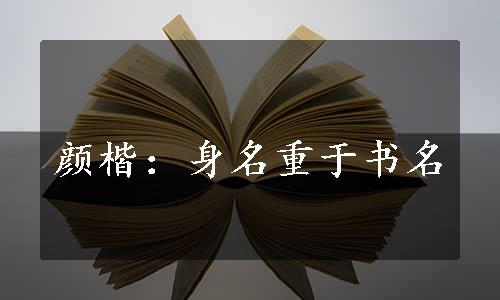
Yan Kai, a reputed calligrapher and politician
晚清民国,四川名士辈出,颜楷便是其中一位。颜楷于1877年生于成都华阳县(今双流)。16岁那年,他以优异的成绩考入翁同龢主办的贵族子弟学堂“南学”。后来,颜楷进入王闿运所办的湖南衡州东州书院。
此时的中国正处在大变局之中。颜楷的父亲与维新派交往甚密,颜楷深受影响。百日维新失败,颜楷目睹六君子就义,悲痛欲绝,自此变得极为消沉。父亲见状,便让他远离京城,将其送回成都华阳县读书。
四年之后,颜楷才学光芒难以掩盖,联捷举人与进士。恰逢清政府“废科举、兴学堂”,引进西方学制,送留学生去日本深造,他也被派赴日本学习法政。两年后他学成归来,进入翰林院供职。不久,朝廷派遣他去广西协办“法政学堂”和“监狱学堂”。
颜楷
Yan Kai
颜楷书法
The callig raphy by Yan Kai
Du ring the late Q ing D ynasty and the Republic of China period, generations of celebrities emerged in Sichuan. Yan Kai was one of them. Yan was born in Huayang County(today’s Shuangliu ), Chengdu on June 4, 1877. At the age of 16, he en rolled, as a top candidate, in the South School, an elite school run by Weng Tonghe. Then, he stud ied at Dongzhou A cadem y in Hengzhou, Hunan, founded by Wang Kaiyun, a famous scholar.
Yan Kai was profoundly inf luenced by refo rm thoughts. When the Hu nd red Day s of Refo r m o r W u xu Refo r m (1898) failed, he w as heartb roken seeing the six gentlem en being executed. Therefore, his father sent him back to Chengdu where Yan Kai enrolled in a school in Huayang. Then he went to Japan for study ing law and politics. Two years later, he graduated and returned to China, and secured an off ice at the Hanlin Academ y. Soon, the Qing cou rt sent him to help run the School of Law and Politics and the School of Prison Off icers in Guangxi.(www.xing528.com)
辛亥秋保路死事纪念碑
The Monument to the Martyrs of the Railway Protection Movement, the Revolution of 1911
1911年,颜楷回成都完婚,再次卷入了一场历史的剧变之中。
这一年5月,清政府下令将原本已经商办的川汉、粤汉铁路收归国有,保路运动就此掀起。颜楷是法律专家,在广西一带已经声名远播,家乡人都引以为傲,他一回来,立即就被各方推上浪尖。颜楷也不满清政府的做法,在铁路公司召开的临时大会上,他当即宣布成立“四川保路同志会”,主动担任了干事长职务。从这一天起,保路运动成燎原之势,在四川大地上熊熊燃烧起来。
为争取路权,颜楷与四川总督赵尔丰据理力争,赵尔丰对其深恨不已。后赵尔丰以反叛罪陷害颜楷一干人等,将其抓捕入狱。这引起了成都百姓的众怒,一时间万人空巷,涌到督院门前请愿,要求释放被捕诸人。赵尔丰竟下令军警开枪,对群众进行镇压。随后,各县纷纷成立“保路同志军”围攻成都,形成了大规模的全川反清武装起义。
保路运动后不久,辛亥革命爆发,清朝灭亡。颜楷不愿再投身政治,转而研习书艺。他幼年学字,早已书名远播。他的字以魏碑为魂,古拙厚重。如今成都人民公园中的“辛亥秋保路死事纪念碑”,其东面的楷书,便是他的笔迹。颜楷退隐后颇为清贫,在成都以鬻字为生,即便如此,他也将所得的收入大半捐与慈善事业。他是时代洪流之下的勇士,也是一名急流勇退的智者。
In 1911, Yan returned to Chengdu to get married and was involved in the Railway Protection Movement. Being a legal expert, he was pushed by various forces to the center of this movement. At an extraordinary general meeting held by the railway firm, Yan announced the establishment of the Association of Com rades for Railway Protection. He volunteered to serve as Director-general of this association.
Shortly after the Railway Protection Movement, the Revolution of 1911 erupted, overthrow ing the Qing Dynasty. Yan Kai was no longer w illing to stay in the political circle, turning to study calligraphy instead. His calligraphy, simple and stately in an old style, captured the soul of the tablet inscriptions of the Northern Dynasties. Yan w rote the inscription in regular script on the east side of the Monument to the Martyrs of the Railway Protection Movement, in today’s People’s Park, Chengdu. A fter retiring from public life, Yan Kai was not welloff and lived on selling his calligraphy works in Chengdu. Even so, he donated much of his income to charitable causes.
免责声明:以上内容源自网络,版权归原作者所有,如有侵犯您的原创版权请告知,我们将尽快删除相关内容。




